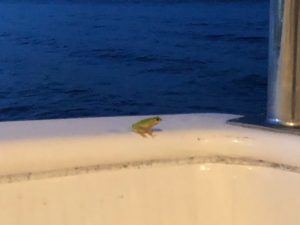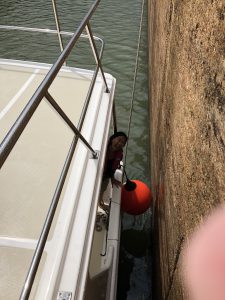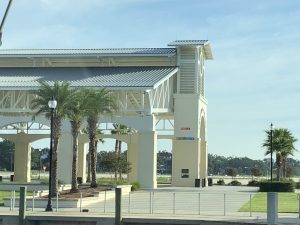7 September 2018: Goodbye Louisiana
The plan was to push from Lafitte early in the morning. We anticipated that we’d have several locks and bridges to pass on our way to the end of the Intracoastal Waterway and out to salt water. Lafitte at pre-dawn was still. A thin layer of fog formed on the water and the shore, coating everything with swampy slickness. One frog, brilliant green, and I imagined desperate to leave the swamp, had climbed aboard sometime in the night and was hanging on the cockpit rail in the morning. It was, all in all, beautiful and calm.

Or at least beautiful until the swamp boats came out. Several boats, filled with Cajuns in a hurry to be someplace came tearing up and down the waterway rending the peace and setting us to rocking with their wakes. That was another thing we noticed about boating here. At home, people are generally pretty conscious of the wake they produce and the affect that the wake has on other boats or shoreline. Here the little boats (for we saw no boats our size) sped along the waterway with what we frowned upon as reckless abandon. On several occasions we had been overtaken or passed by boats speeding along at double or maybe triple our cruising speed (7.5 knots) by mere yards.
I guess to each area, a different custom.
The day’s plan was to follow the ICWW until it intercepted the Mississippi. We would have one lock to enter the river, which we would then ride downstream some ways. Riding the Mississippi, we’d go through the heart of the city—the French Quarter. What a cool way to see New Orleans! Then we would leave the Mississippi, turning into the Industrial Canal, where we’d have a second lock. The canal would go through the delta of the great river into lands currently designated as protected wetlands, to emerge from the floodwalls built around New Orleans after Katrina, into the Mississippi Sound.
As we approached the City of Saints, however, the sky lowered and darkened. Was it my imagination, or did the air thicken, as if it were slowly cooling molasses?
We made it through the first lock, the Harvey Lock, without getting too wet. This was the first time we had to tie up to lock. The locks were deep, the wall some fifteen feet above us. And again, we were the only vessel “in the chamber.” The dockmaster took one line only; in the Harvey Lock he asked for the bowline. The change was only two feet, and before we knew it, the doors were popping open, ushering us into the mighty Mississippi River.
The river itself was wide and deep. As soon as we emerged into the river we were greeted by river traffic control. Not kidding. We said hello and told them where we were going. He told us what kind of traffic was on the river, and who was coming our way. It was a surprise and a pleasure. And we shot down the river, taken by its seemingly gentle current, cruising for the first time at 10.5 knots.
By the time we turned into the forebay for the Industrial Lock, however, the city’s thunderstorm had burst and it was raining with determination. A thick, soaking downpour.
The chamber of the Industrial Lock is immediately preceded by a railroad bridge that the charts all declared had zero clearance when closed. That’s not entirely true, as when we had arrived in the forebay, the tug immediately before us in the queue had already pushed its cargo of barges under the bridge and was waiting for the bridge to raise to clear the bridge of the tug. It looked like some mechanical anteater with its long snout in an anthill.
Anyway, we were instructed to an out of the way area to wait for the lock to cycle and were able to tie up to wait. We all got seriously wet while tying up. And then it really started to rain, shocking us that it could rain even harder than before. Tied up as we were in the little protected niche and being availed of some tens if not hundreds of gallons of free water, we made a virtue of the circumstance to wash the bugs and swamp grime from Adventuress’ decks while we waited.
It was still raining when we passed into the chamber of the Industrial Lock, sometime later. But helpfully the rain was slowing, and by the time we were finished locking, had stopped all together. By this time, however, every line was absolutely waterlogged, and we’d have to figure out how to dry the lines before stowing them away.
The passage through the second lock was, again, as different as locking through the Ballard Locks as cheese is to chalk. Again, the dockmaster took only one line. An older gentleman, the dockmaster was gray and grizzled with unkempt tufts of gray curls sticking out of either side of a bald pate like two horns. He seemed somewhat taken aback that I knew what to do. But I paid no attention to his preconceived notions, got Adventuress ready for the locking, and in two feet we were done.

Beyond the Industrial Lock, the Industrial Canal made its way from New Orleans through the silty delta that the river had built up over the uncounted eons. Unlike the bayou, with its tall trees crowding cheek by jowl, the delta was grassy. Tall grasses lined either side of the canal, and the below sea level delta provided good visibility for miles for anything taller than a few feet. It reminded me of Egyptian tomb paintings of kingly pharaoh striding through the marshes hunting ducks or hippopotamuses.
And it seemed that the boat gods were smiling on our decision to return to the salty brine. The sun emerged from the black clouds now receding astern, and the sky ahead was blue, clean, and cloudless.
Ringed around the delta is a monument to human engineering. Or, I might say hubris that humans could control the elements so. A floodwall, some twenty-five or thirty feet high, stretching around the marsh. At exit points were great floodgates. This day they stood open. A few days ago, when New Orleans was expecting a call from Gordon, I imagined these great gates were shut against the storm’s surge, like a modern Great Wall shut up against barbarian hordes.
And passing through these gates, we were back in salt water.
It is said that the sea is fickle, and that was certainly the case. The last time we were in the Gulf of Mexico, we had fled her winds and wave action. This day, the sun was warm, the wind was mild, and the seas were welcoming. Gentle one, or maybe two-foot waves rocked us in gentle motions across the Mississippi Sound to our evening’s destination, Gulfport Mississippi.
The Gulfport Municipal Harbor was hailed as a premier marina, with the full panoply of services in a clean, new marina. They were not wrong. It was clean, it was new, and it was very classy. It had its own lighthouse to guide weary mariners to safe harbor. We settled in just about dusk and were met at the dock by a chatty marina attendant who skillfully handled our lines as we tied up to their high dock. And by high, I mean, OMG-I-need-a-hand-here-help-a-girl-out high. The marina attendant gave us a great recommendation for food, a grocery, and told us that the marina had been completely wiped out by Katrina. Every dock, every building, every pylon gone. On the office building at the head of the dock, a red sign marked Katrina’s high-water mark. It was halfway up the second floor.

We did take the attendant’s recommendation on a restaurant. We were hungry, and we made the short trek along the beach to Shaggy’s. Shaggy’s was a beach shack, complete with brightly painted tables, open rafters, and trophy fish hanging on the walls. A shark hung to mark the cash register, posed to be forever gnawing on a flip-flop. Fish was the specialty of the house, and the oysters were divine.
Next, we hit the grocery. The attendant’s suggestion was to Uber to a grocery some six or so miles away. That puzzled us as there was another grocery much closer. We went to the close grocery. It wasn’t empty, or it seemed to us a terrible grocery. The store was one of those grocery outlets, where everything was an off-brand and everything was cheap. We didn’t really notice that everyone in the store was black until our Uber driver remarked that we HAD have a pickup here, and she had to lock her doors, even though there wasn’t a soul in the parking lot (it was maybe 2000 or 2030 hours). Ah, we remarked to ourselves, the casual racism seemed obvious to us. We wondered if she saw it.
Tomorrow, assuming the weather cooperated, we would push out of Gulfport mid-morning, and run overnight to Panama City, some 250 or so miles east.